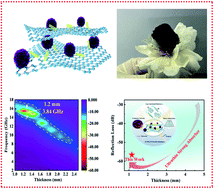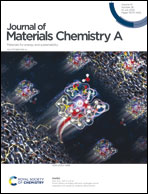A freestanding 3D heterophase tungsten disulfide-based aerogel as an ultrathin microwave absorber in the Ku-band†
Abstract
Ingenious dielectric tuning strategies are challenging to set up with high-efficiency microwave absorbing (MA) materials that absorb strongly at the ultrathin absorber level. In this work, an aerogel with a dual three-dimensional (3D) conductive network was constructed using a solvothermal and ice template-assisted freeze-drying process, namely, 1T-tungsten disulfide/carbon nanotubes-reduced graphene oxide (1T-WS2/CNT-rGO). Numerous small-scale staggered 2D nanosheets were assembled into nanoflower-like WS2, forming a unique conductive network. Meanwhile, the CNT-rGO acted as the 3D aerogel scaffold to support the WS2 and provided a 3D conductive network to facilitate electronic hopping. The tremendous 1T-phase thus introduced significantly promoted the charge transfer capability at the 1T/2H heterointerface and enriched the phase interface polarization. Benefiting from the synergistic effect of enhanced polarization loss and optimized impedance matching, the thickness of 1T-WS2/CNT-rGO was merely 1.15 mm corresponding to the minimum reflection loss (RLmin) of −56.63 dB; the maximum effective absorption bandwidth (EABmax) reached 3.84 GHz. Furthermore, the simulation results verified that the absorber coating could effectively suppress the radar cross-section (RCS) of strong metal scattering sources to different degrees. Consequently, the potential of 1T-WS2/CNT-rGO to be employed as the new generation of ultrathin and high-efficiency absorbers can be predicted.



 Please wait while we load your content...
Please wait while we load your content...